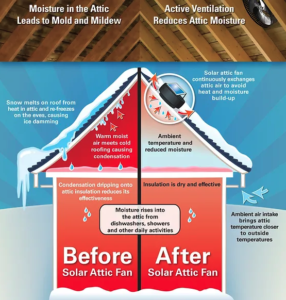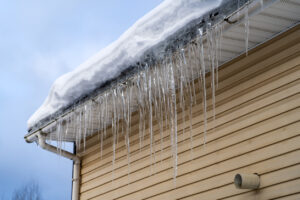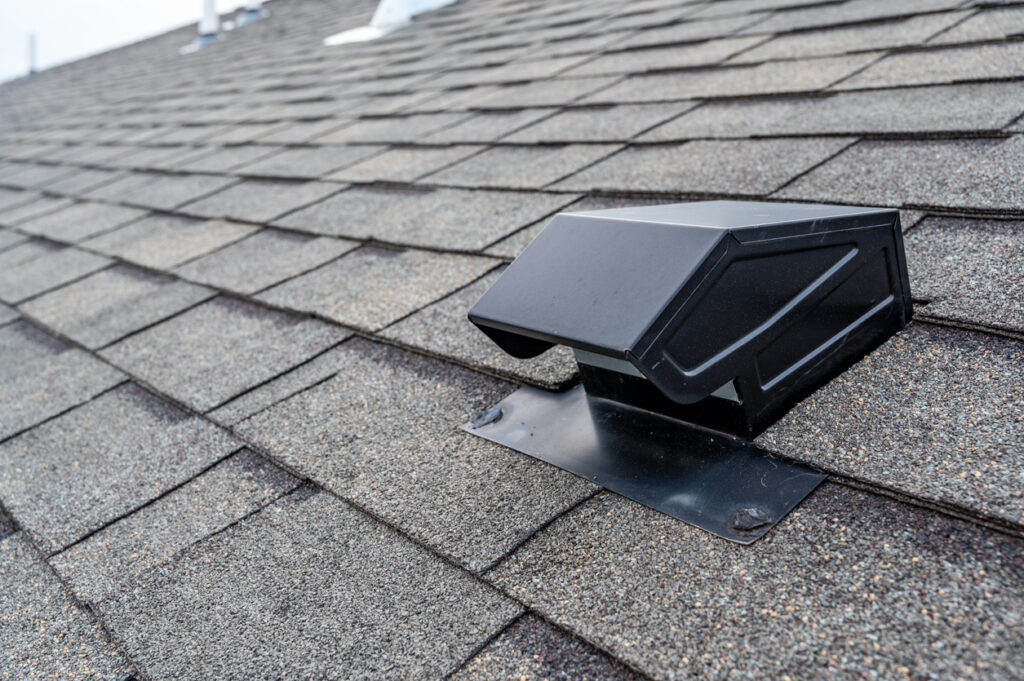When it comes to maintaining a healthy shingle roof, ventilation plays a crucial role. Proper ventilation helps to regulate the temperature and moisture levels in the attic, which in turn can help to prevent damage to the shingles and prolong the lifespan of the roof.
In West Michigan, where the climate can be harsh and unpredictable, it is especially important to ensure that your roof is properly ventilated.
One of the main benefits of proper ventilation is that it helps to prevent moisture buildup in the attic. In the winter months, warm air from the living space below can rise into the attic and condense on the underside of the roof deck, leading to water damage and mold growth.
In the summer months, hot, humid air can become trapped in the attic, causing the shingles to deteriorate more quickly. Proper ventilation helps to prevent these issues by allowing air to circulate through the attic, keeping the temperature and moisture levels in check.
Another benefit of proper ventilation is that it can help to reduce energy costs. In the summer months, a poorly ventilated attic can trap hot air, causing the temperature in the living space below to rise and making your air conditioning work harder. In the winter months, a poorly ventilated attic can allow heat to escape, leading to higher heating bills. By ensuring that your roof is properly ventilated, you can help to keep your energy costs under control.
The Importance of Ventilation for Shingle Roofs
The Basics of Shingle Roof Ventilation

Proper ventilation is essential for maintaining a healthy shingle roof. Ventilation helps to regulate the temperature and moisture levels in the attic space, which can have a significant impact on the lifespan of the shingles.
The Effects of Poor Ventilation on Shingle Roofs
Poor ventilation can have a significant impact on the lifespan of a shingle roof. When the attic space is not properly ventilated, moisture can build up, leading to the growth of mold and mildew. This moisture can also cause the shingles to deteriorate and weaken, leading to premature failure. In addition to moisture issues, poor ventilation can also lead to temperature fluctuations in the attic space.
Climate Considerations for West Michigan
Overview of West Michigan Climate
West Michigan experiences a humid continental climate, characterized by cold winters and warm summers. The region receives an average of 34 inches of precipitation per year, with snowfall being a common occurrence during the winter months. The proximity of Lake Michigan also impacts the climate, with the lake effect causing a significant amount of snowfall in some areas.
How Climate Affects Shingle Roofs
The harsh weather conditions in West Michigan can take a toll on shingle roofs, causing damage and reducing their lifespan. The extreme temperature fluctuations, high winds, and heavy precipitation can cause shingles to crack, warp, or become loose. The accumulation of snow and ice on the roof can also lead to ice dams, which can cause water to seep into the roof and damage the underlying structure.

Proper ventilation is crucial in maintaining the health of a shingle roof in West Michigan. In the summer, proper ventilation helps to prevent the buildup of heat and moisture in the attic, which can cause shingles to deteriorate and reduce their lifespan. In the winter, proper ventilation helps to prevent ice dams by keeping the roof temperature consistent and preventing the buildup of snow and ice on the roof.
Homeowners in West Michigan should also consider the use of reflective roofing materials, which can help to reduce the amount of heat absorbed by the roof during the summer months. This can help to lower energy costs and reduce the strain on the air conditioning system.
Types of Ventilation Systems
Passive Ventilation Systems
Passive ventilation systems rely on natural forces like wind and convection to circulate air through the attic space. They do not require any mechanical components or electricity to function. Ridge vents, soffit vents, gable vents, and static vents are all examples of passive ventilation systems.
Ridge vents are installed at the peak of the roof and allow hot air to escape from the attic space. Soffit vents are installed under the eaves of the roof and allow cool air to enter the attic space. Gable vents are installed on the sides of the roof and allow hot air to escape. Static vents are installed on the roof and use wind to create a vacuum effect that pulls hot air out of the attic space.
Active Ventilation Systems
Active ventilation systems use mechanical components like fans and motors to circulate air through the attic space. They require electricity to function and are more effective at removing hot air from the attic space than passive ventilation systems. Power vents, turbine vents, and electric fans are all examples of active ventilation systems.
Power vents are installed on the roof and use a motor to pull hot air out of the attic space. Turbine vents are installed on the roof and use wind to spin a turbine that pulls hot air out of the attic space. Electric fans are installed in the attic space and use a motor to circulate air through the attic space.
Choosing the Right Ventilation System for Your Shingle Roof
When choosing a ventilation system for your shingle roof in West Michigan, it is important to consider factors like the size of your attic space, the pitch of your roof, and the climate in your area. Passive ventilation systems are generally less expensive and require less maintenance than active ventilation systems, but they may not be as effective in areas with low wind speeds or high humidity levels.
Active ventilation systems are generally more effective at removing hot air from the attic space, but they require electricity to function and may be more expensive to install and maintain. A roofing professional can help you determine which type of ventilation system is best for your shingle roof in West Michigan.
Installation and Maintenance of Ventilation Systems
Proper installation and maintenance of ventilation systems are crucial for maintaining a healthy shingle roof, especially in climates like West Michigan. Here are some best practices for installing and maintaining ventilation systems:
Best Practices for Installing Ventilation Systems
When installing a ventilation system, it is important to ensure that the system is properly sized for the roof and attic space. A system that is too small will not be effective in removing moisture, while a system that is too large can create negative pressure in the attic and draw conditioned air out of the living space.
The location of the ventilation system is also important. The system should be installed near the peak of the roof to allow for the most effective airflow. Additionally, it is important to ensure that the system is installed evenly on both sides of the roof to prevent uneven ventilation.
Finally, it is important to use quality materials when installing a ventilation system. Low-quality materials can deteriorate quickly and compromise the effectiveness of the system.
Maintenance Tips for Ventilation Systems
Maintaining a ventilation system is just as important as installing one. Here are some tips for keeping your ventilation system in top condition:
- Regularly inspect the system for damage or blockages. Remove any debris or obstructions that may be hindering airflow.
- Clean the system at least once a year to remove any dust or dirt that may have accumulated.
- Check the system’s components, such as fans and motors, to ensure that they are functioning properly.
- Replace any damaged or worn components as soon as possible to prevent further damage to the system.
By following these best practices for installation and maintenance, homeowners can ensure that their ventilation system is functioning properly and effectively maintaining a healthy shingle roof.
For further reading, please check out this article we found to be very informative on healthy roof ventiliation.
Wrap Up
Proper ventilation is essential for maintaining a healthy shingle roof in West Michigan. Without proper ventilation, a shingle roof can become damaged and deteriorated, leading to costly repairs and replacements.
Through this article, it has been demonstrated that a well-ventilated roof can help prevent moisture buildup, reduce heat buildup, and increase the lifespan of the shingles. Additionally, proper ventilation can help prevent ice dams in the winter, which can cause significant damage to a roof.
It is important to note that the specific ventilation needs of a shingle roof can vary depending on factors such as the size of the roof, the type of shingles used, and the climate in which the roof is located. Therefore, it is recommended that homeowners consult with a roofing professional to determine the appropriate ventilation system for their specific roof.
By investing in proper ventilation, homeowners can ensure the longevity and health of their shingle roof, saving them time and money in the long run.
West Michigan Roof and Gutter has an experienced professional waiting to help you in answering any questions you may have about your home’s ventilation needs. Please fill out the form at the top of the page and someone will be in touch within 24 hours.

